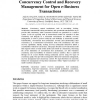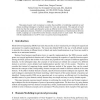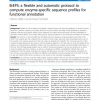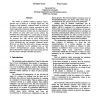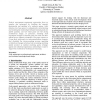811 search results - page 71 / 163 » Supporting Flexible Business Processes with a Progression Mo... |
WOTUG
2007
13 years 10 months ago
2007
Concurrency control mechanisms such as turn-taking, locking, serialization, transactional locking mechanism, and operational transformation try to provide data consistency when con...
FDL
2005
IEEE
14 years 2 months ago
2005
IEEE
This paper presents work in progress to explore the possibility of combining model-driven and domain modeling techniques to facilitate support for reuse and automation. The approa...
BMCBI
2010
13 years 6 months ago
2010
Background: Models for the simulation of metabolic networks require the accurate prediction of enzyme function. Based on a genomic sequence, enzymatic functions of gene products a...
ICDE
1995
IEEE
14 years 10 months ago
1995
IEEE
The model of flexible relations supports heterogeneous sets of tuples in a strongly typed way. The elegance of the standard relational model is preserved by using a single, generi...
RE
2001
Springer
14 years 1 months ago
2001
Springer
Today's requirements engineering approaches focus on notation and techniques for modeling the intended functionality and qualities of a software system. Little attention has ...
